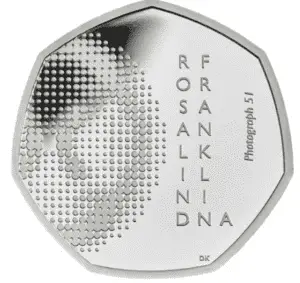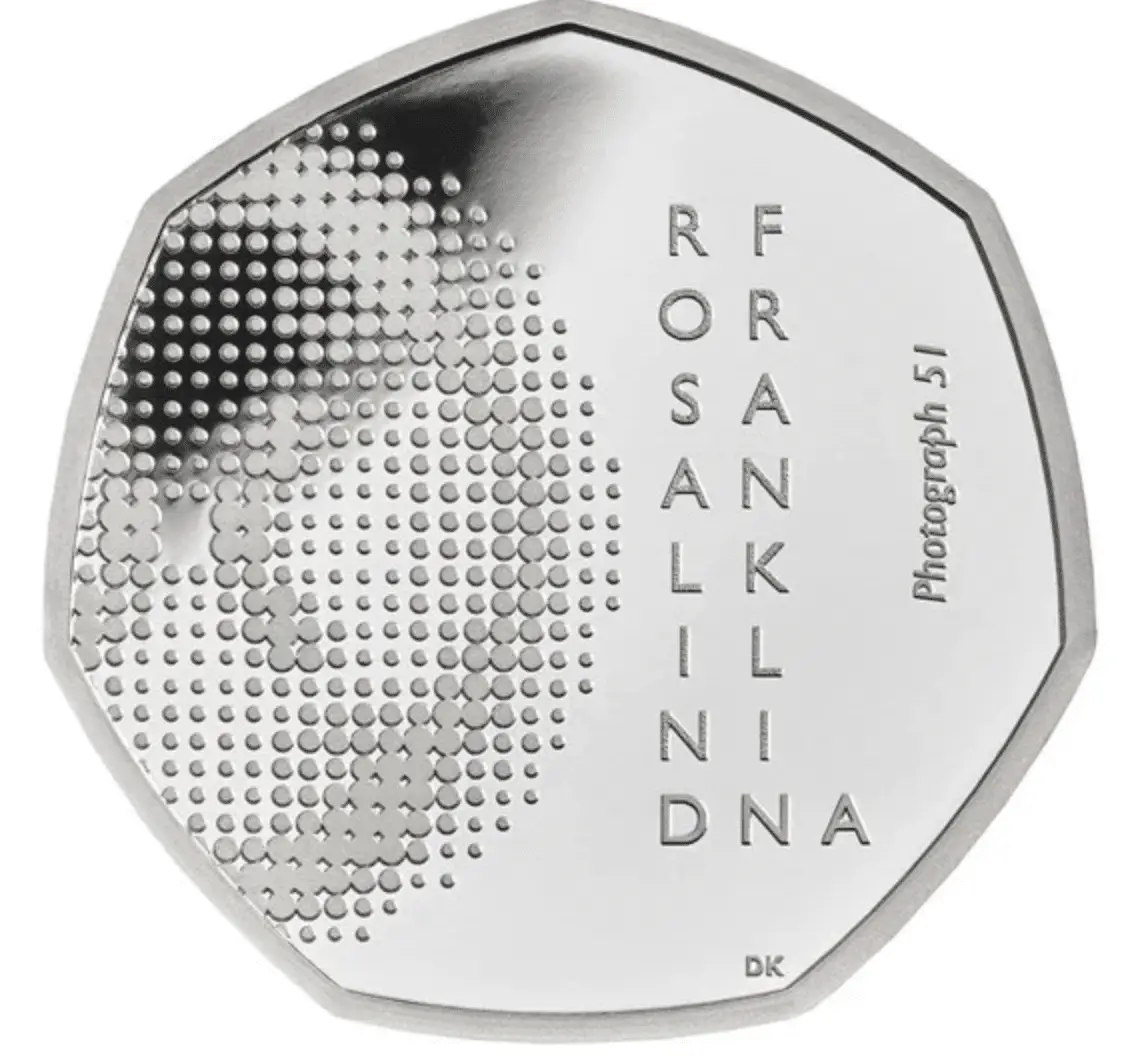As the second coin in the Royal Mint innovation in science series, the Rosalind Franklin commemorative 50p pays tribute to what would be Franklin’s 100th birthday. The coin comes after the Stephen Hawking 50p which was released in 2019 following the death of Hawking in 2018 after his hard-fought battle with motor neurone disease. The Stephen Hawking 50p was the first time that Hawking had been portrayed on a coin in the UK, similarly with the Rosalind Franklin 50p.
Who was Rosalind Franklin?
Rosalind Elise Franklin was born in Notting Hill, London on the 25th July 1920 and worked as a chemist. Franklin got her education at a private school in London and went on to study Natural Sciences at Newnham College, Cambridge. After her graduation in 1941, Franklin became a research fellow under Ronald Norrish, who won the Nobel Prize for Chemistry in 1967 for his studies into fast chemical reactions.
Franklin was offered a research position at British Coal during her research, where she earned a PhD in 1945. 2 years after this, Franklin went to Paris to learn more about x-ray crystallography, an experimental technique used to determine the atomic and molecular structure of crystals. A few years later Franklin returned to England to become a research associate at King’s College London, taking with her the knowledge she had gained from France.
It was at King’s College where Franklin would undertake her most influential work relating to imaging of DNA structures.
After a disagreement with her director and colleagues at King’s College, Franklin decided to move to Birkbeck College in 1953. Whilst there Franklin led research into the molecular structure of viruses.
Unfortunately, Franklin became ill and died of ovarian cancer in April 1958 at only 37 years old. Despite her illness, she was incredibly able to continue working and was even promoted in February 1958 to Research Associate in Biophysics just 2 months before her death.
Franklin was never able to achieve the Nobel Prize in Chemistry due to her life being taken from her at such a young age. The images she was able to obtain of the structure of DNA whilst at King’s College, most notably photograph 51, allowed for the discovery of the DNA double helix by her colleagues in 1962. This discovery meant they were awarded the Nobel Prize, with one of the colleagues stating that it would have been ideal for Franklin to get the award alongside them.
It was not only her work at King’s College that was worthy of a Nobel Prize, however. Her team member at Birkbeck Aaron Klug went on to win the Nobel Prize for Chemistry in 1982 by continuing the work that he had undertaken with Franklin.
The decision by the Royal Mint to commemorate the life of Franklin, someone who was never truly awarded for what she had achieved during her time, will hopefully bring more attention to how influential she was in her field.
Design of the Rosalind Franklin 50p
The Royal Mint worked in partnership with King’s College London to create the design of the Rosalind Franklin 50p coin. By designer David Knapton, as shown by the initials towards the bottom of the coin, the Rosalind Franklin 50p features a design inspired by photograph 51 created using printing techniques from the era.
The half-tone effect used creates a brilliant contrast to the finish of the coin and makes the design stand out. If you decide to pick up one of these coins, you can see for yourself just how brilliant the finish of this coin is. Another nice touch is the inscription of ‘DNA’ which lines up towards the right of the bottom half of the coin.

Photograph 51 refers to the most iconic photograph taken via x-ray diffraction from Franklin’s time researching at King’s College. The photograph shows a pattern of DNA taken from a DNA fibre. The photograph itself was taken by Raymond Gosling, who worked under the supervision of Franklin. It was used as key evidence in developing the chemical model of a DNA molecule and was used by Maurice Wilkins, Francis Crick and James Watson to win the Nobel Prize in 1962.
What versions of the coin are available to buy?
Currently, there are brilliant uncirculated, silver proof, silver proof piedfort and gold proof versions of the coin available to purchase at the Royal Mint.
The brilliant uncirculated version of the coin costs £10.00 with educational packaging and is minted from cupro-nickel to a high specification. This version weighs 8.00 grams with a diameter of 27.30mm, the same specification as circulating 50p coins in the UK.
The silver proof version costs £55.00 with the added benefit of being produced from 0.925 sterling silver and coming inside a coin case with certificate. The specification for this coin is also a weight of 8.00 grams and a diameter of 27.30mm. There is a limited production of just 3,500 of this version of the coin
The silver proof piedfort costs £95 and weighs exactly double at 16.00 grams thanks to the piedfort specification – yet again minted from 0.925 sterling silver with a diameter of 27.30mm. The production of this version is only 1,500. and comes with a case and certificate.
Last but certainly not least comes the gold proof version, with a limited edition of only 250 this coin costs £1,075.00 to purchase. Also presented with a display box and certificate, this coin also features an educational booklet. Weighing in at 15.50 grams with a diameter of 27.30mm, it is minted from 22-carat gold, the most expensive of all the metals used in the series.
Is The Rosalind Frankling 50p Going Into Circulation?
The question everyone seems to be asking, unfortunately, we do not have a definitive answer as of yet. The likelihood of the coin entering circulation will depend vastly on the public demand for the coin. The innovation in science series is sure to continue throughout the years so there will be plenty of opportunities for the Royal Mint to introduce one of these coins into general circulation.
Interestingly the Stephen Hawking 50p never made it into circulation, but does that mean the same for the Rosalind Franklin 50p? Only time will tell.
As of October 2021, the coin has not been entered into circulation, and as such, it is looking increasingly likely that it will remain this way in the future.
Is it worth collecting?
Being part of a Royal Mint series of coins is always a good point to note for any particular coin’s collectability. In this case, there are currently only two coins in the innovation in science series, with more sure to come.
In addition to being part of a new and upcoming series, the Rosalind Franklin 50p is also available in many different versions including those with silver and gold, as previously mentioned. Commemorative coins are usually produced in these different precious metals, which allows them to hold value much better than just a cupro-nickel finish.
In addition to this, there is a limited amount of each version available to buy. It is clear that the Royal Mint produces these coins for them to be collectable and worthwhile to hold on to for the future.
It’s difficult to come up with an argument that would suggest not picking up a particular version of this coin, especially the silver or gold versions, and even more so when considered alongside a Stephen Hawking 50p to complete the collection so far.
You can buy any particular version of the coin from the Royal Mint
